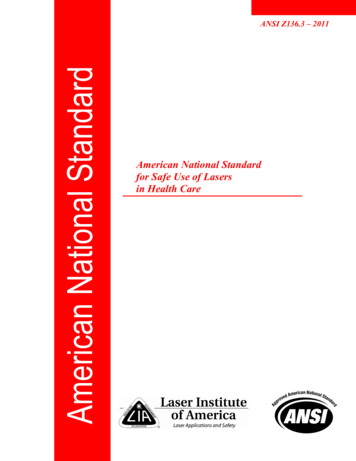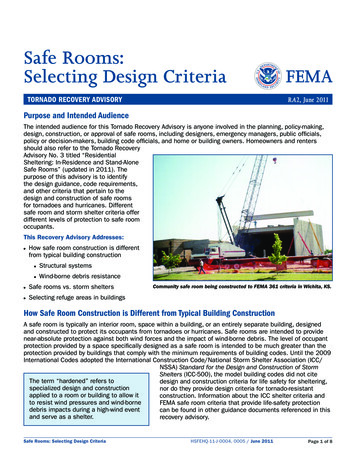
Transcription
American National StandardANSI Z136.3 – 2011American National Standardfor Safe Use of Lasersin Health Care
ANSI Z136.3 – 2011Revision ofANSI Z136.3-2005American National Standardfor Safe Use of Lasersin Health CareSecretariatLaser Institute of AmericaApproved: December 5, 2011American National Standards Institute, Inc.
AmericanNationalStandardAn American National Standard implies a consensus of those substantiallyconcerned with its scope and provisions. An American National Standardis intended as a guide to aid the manufacturer, the consumer, and thegeneral public. The existence of an American National Standard does notin any respect preclude anyone, whether or not he or she has approved thestandard, from manufacturing, marketing, purchasing, or using products,processes or procedures not conforming to the standard. AmericanNational Standards are subject to periodic review and users are cautionedto obtain the latest editions.CAUTION NOTICE: This American National Standard may be revisedor withdrawn at any time. The procedures of the American NationalStandards Institute require that action be taken periodically to reaffirm,revise, or withdraw this standard no later than five years from the date ofpublication. Purchasers of American National Standards may receivecurrent information on all standards by calling or writing the AmericanNational Standards Institute.Published byLaser Institute of America13501 Ingenuity Drive, Suite 128Orlando, FL 32826ISBN: #978-0-912035-69-7Copyright 2011 by Laser Institute of America.All rights reserved.No part of this publication may be copied or reproduced in any form, includingan electronic retrieval system or be made available on the Internet, a public network,by satellite, or otherwise, without the prior written permission of the publisher.Printed in the United States of America.
ContentsSECTIONPAGE1. General .11.1 Scope .11.2 Application: Hazard Classification Scheme .21.3 Laser Safety Officer (LSO) .71.4 Environment .92. Definitions.103. Hazard Evaluation and Classification .173.1 General .173.2 Laser Considerations.183.3 Laser and Laser Systems Hazard Classification .193.4 Laser Use Environment: Operating or Treatment Rooms .193.5 People Who May be Exposed .194. Control Measures .194.1 General Considerations .194.2 Administrative Controls .204.3 Equipment Controls .224.4 Laser Use Environment (Class 3B and Class 4). .234.5 Maintenance, and Service Procedural Controls. .254.6 Protective Equipment .264.7 Area Warning Signs and Equipment Labels .284.8 Exhibits, Demonstrations and Clinical Training .295. Laser Safety Programs .305.1 Administration. .305.2 Training .306. Medical Examination of Health Care Personnel (HCP) .316.1 Examinations Following a Suspected or Actual Laser-Induced Injury. .316.2 Medical Surveillance .327. Non-Beam Hazards .327.1 General .327.2 Electrical Hazards. .327.3 Infection Control .337.4 Laser Generated Airborne Contaminants (LGAC). .337.5 Collateral and Plasma Radiation .347.6 Fire and Explosion Hazards. .357.7 Electromagnetic Interference and Susceptibility .367.8 Endoscopic Delivery Systems.367.9 Waste Disposal.377.10 Laser Gases and Dyes .37xi
ContentsSECTIONPAGE7.11 Room Design .378. Criteria for Exposure of the Eye and Skin .379. Measurements .379.1 Beam Shape, Alignment and Testing.3710. Revision of Standards Referred to in this Document.3810.1 ANSI Standards .3810.2 Other Standards and Codes .38TablesTable 1. Requirements by Laser Classification .3Table 2. Comparison of National and International Standards for Classification .4Table 3. Control Measures for the HCLS .39FiguresFigure 1a. Sample Area Warning Sign for Class 2 and Class 2M Lasers .40Figure 1b. Sample Area Warning Sign for Class 3R, Class 3B, and Class 4 Lasers .41Figure 1c. IEC Warning Logo and Information Label .42Figure 1d. Sample Area Warning Sign for Temporary Laser Controlled Area .43Appendix ALasers Used in Medicine and Surgery .45A1. General. .45A2. Laser-Tissue Interaction .45A3. Lasers .46TablesTable A1 Wavelength Effects for Various Lasers .49Table A2 Ocular MPEs for Selected Surgical/Medical Lasers .50Table A3 NHZ Distances for Selected Surgical Lasers without Delivery SystemConstraints .51Table A4 Laser Criteria used for NHZ Distance Calculations .51Appendix BUse of Lasers in Health Care .52B1. General .52B2. Photodynamic Therapy (PDT) .58FormsForm B1 Example Perioperative Laser Safety Checklist .60Form B2 Example Laser Operator Skills Validation .62xii
ContentsSECTIONPAGEAppendix CSpecialties .63C1. General. .63C2. Gynecology .63C3. Neurosurgery .66C4. General Surgery.68C5. Dermatology .69C6. Urology.72C7. Ophthalmology .74C8. Otolaryngology.77C9. Anesthesiology .79C10. Podiatry .81C11. Dentistry .86C12. Cardiovascular .91C13. Orthopedics .92C14. Perioperative and Aesthetic Laser Safety (Nursing and Allied Health).94C15. Veterinary Medicine .95TablesTable C5.1 Clinically Used Lasers in Dermatology .71Table C11.1 Indications for Use .88Table C11.2 Safety Zones for Some Dental Lasers .90Table C11.3 Laser Classifications in Dentistry .90Table C13.1 Type of Laser Used in Orthopedics .92Appendix DASLMS Standards of Training for Physicians for the Use of Lasers in Medicine andSurgery .98D1. Training .98D2. Credentialing .98Appendix EASLMS Non-Physician Laser Use .100E1. Principles for Non-Physician Use of Laser and Related Technology. .100E2. Educational Recommendations for Laser Use by Non-Physicians .100Appendix FLaser Safety and Training Programs.102F1. General .102F2. Health Care Facility LSO .102F3. Laser Equipment Service Personnel .102TablesTable F1 Laser Safety Education Program .104Table F2 Laser Safety Training Program.104xiii
ContentsSECTIONPAGEAppendix GFederal Regulatory Considerations .105G1. General .105G2. Federal Laser Product Performance Standard (FLPPS) .105G3. Medical Devices .106G4. References .107Appendix HSample Policies and Procedures (P&Ps).108Controlled Access to the Laser Room .109Ocular Safety .110Handling of Laser Fiber Delivery Systems .111Non-Beam Hazards .112Index .114xiv
American National Standard forSafe Use of Lasers in Health Care1. General1.1 Scope.This standard provides guidance for the safe use of lasers in health care. Specific processes areprovided to protect anyone who might become exposed to laser radiation and to assist inestablishing a program that promotes the safe use of health care lasers. The scope of this standardincludes all circumstances when people may be exposed to a laser used in health careapplications where:1) Laser systems as medical devices are used for diagnosis of disease, or for preventive,aesthetic, or therapeutic purposes2) Bodily structure or function is altered, or symptoms are relieved3) Any application where a laser is applied by people for health care purposesThis standard applies to any location where a health care laser system (HCLS) is being used as amedical device, including hospital facilities, non-hospital facilities, outpatient facilities,individual medical, dental and veterinarian offices, and non-medical locations, such as salonsand spas. Laser radiation as defined herein refers to the ultraviolet, visible, and infrared regionsof the electromagnetic spectrum and should not be confused with ionizing radiation.A laser used in these applications is incorporated into an apparatus that includes:1) A delivery system to direct the output of the laser2) A power supply with laser control and calibration functions3) Mechanical housing with interlocks4) Associated liquids and gases if required for the operation of the laserThis standard pertains to the safe use of the entire apparatus, which is referred to as an HCLS.This standard is intended for use by all people associated with the application, installation,operation, calibration, and maintenance and service of an HCLS and anyone who might beexposed to lasers being used as medical devices for health care applications.This standard recognizes the need for employers to provide proper laser safety policies andprocedures and training in safe laser use for health care applications, in order for their personnelto be responsible in laser use. In this standard, the principal hazard control rests with the laseruser whose responsibility is to know and follow the guidelines stated in this standard.This standard includes engineering, procedural and administrative controls, and laser safetytraining necessary for the safety of people who may be exposed. These controls are based upon:evaluation of potential hazards from laser radiation; unique problems related to hospitals andoperating rooms (ORs) and non-hospital settings such as outpatient clinics, mobile laser units,1
standard, from manufacturing, marketing, purchasing, or using products, processes or procedures not conforming to the standard. American National Standards are subject to periodic review and users are cautioned to obtain the latest editions. CAUTION NOTICE: This American National Standard may be revised or withdrawn at any time.










